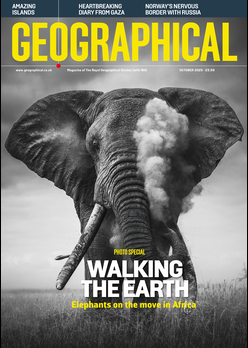
Discover the top five largest lakes across the world according to their area, from those in Africa to North America
By Charlotte O’Gorman Lalor
There are 304 million lakes across the world, spanning diverse environments, from mountain tops, to deserts, plains and seashores.
Formed through glacial, tectonic and volcanic processes, or human activities including damming, lakes vary in size. But where exactly are the largest ones? Here are the top five biggest lakes on our planet, in reverse order:
5) Lake Michigan

Lake Michigan is the third largest of the North American lakes, spanning an area of 57,757 square kilometres – roughly the size of Croatia – with 12 million people living on its shores.
Its name is believed to originate from the native Ojibwe word ‘michi-gami’, which translates to great water. This shows the central role of this lake in the lives of indigenous Native American tribes who call its shores home. The Potawatomi, Chippewa and Ojibwe utilised the lake’s resources for sustenance, commerce and cultural practices.
Lake Michigan is also known for its beaches, particularly those in Michigan and Wisconsin. The eastern shore of Lake Michigan features the largest freshwater sand dunes in the world – with Sleeping Bear Dunes National Lakeshore attracting 1.5 million people annually.
4) Lake Huron

Lake Huron – the second largest of North America’s Great Lakes – comes next. Located between Michigan to the West and Ontario, Canada, to the North, its area amasses 59,570 square kilometres. Its name is a testament to its indigenous history and the Huron people who lived by its shores – five allied tribes of the Iroquoian nation.
However, its connection to Lake Michigan by the Straits of Mackinac has supported the argument that this is one body of water – Lake Michigan-Huron. Nevertheless, they are usually regarded as separate bodies of water.
Lake Hurons’ strong currents, rolling waves and strong winds mean it has earned a reputation as a ‘shipwreck alley’, the resting place for over 1000 wrecks.
Lined by fishing villages, ports and resorts, the lake also facilitates the commercial transport of iron ore, grain and limestone cargo.
3) Lake Victoria

Lake Victoria, dubbed the ‘greatest lake in Africa’ is located within the Western part of the Rift Valley. The lake is shared by Kenya, Tanzania, and Uganda. It boasts an area of 69,484 square kilometres, covering an area around the size of Scotland. With a breathtaking archipelago of 2000 islets and reefs – combined with an abundance of mammals including hippos, crocodiles and fish – and freshwater fish, it is no wonder that hundreds of thousands of people visit Lake Victoria annually.
However, Lake Victoria faces the increasing threat of pollution. In recent years, industries and informal settlements have discharged untreated effluent into the river. Coupled with land management that has removed the wetland barrier and fertiliser and chemical run-off from agriculture, this has resulted in mass algae blooms and eutrophication.
With 50 per cent of fish species within the lake gone, this threatens the lifestyles of 2 million people employed by the aquaculture industry around Lake Victoria and those who rely on it for food.
In response, the Kenya Marine and Fisheries Research Institute (KMFRI), has identified 13 key fish breeding zones along Lake Victoria. These sites are key to ensuring long-term improvement in fish stocks by demarcating zones of limited access for fishermen.
2) Lake Superior

Lake Superior is the largest of the great lakes in North America, a chain of lakes located at the Canada-US border. Its impressive area of 82,000 square kilometres extends across Wisconsin, Michigan, Minnesota and Ontario, Canada. Charged by approximately 200 rivers, including the Nipigon and Saint Louis Rivers, it contains 10 per cent of the world’s fresh surface water – enough to cover the whole of North and South America with 1 foot of water.
This lake is oligotrophic (low in nutrients), but is still able to support an ecosystem of plankton, invertebrates and cold-water fish – some unique to this environment – including the Siscowet. By generating cooler temperatures, fog and mist, it also creates microhabitats for plants, including moss and lichen. This biodiversity is safeguarded by the Lake Superior National Marine Conservation Area, alongside conservation groups.
Recently, a group of swimmers completed a 24-hour, 48-mile relay across Lake Superior, making it the longest observed, documented swim in Lake Superior without wetsuits or artificial aids.
1) The Caspian Sea

The Caspian Sea tops this list as the largest lake in the world. Spanning 386,400 square kilometres – an area larger than Japan – it stretches across Eurasia and lies at the crossroads of Russia, Kazakhstan, Turkmenistan, Iran and Azerbaijan.
Its basin is isolated with no connection to other oceans, relying on the Volga River and smaller rivers including the Ural, the Kura and Terek for freshwater inputs. However, its high salinity of 12.8 parts per thousand means it has one-third of the salinity of average seawater.
In 2018, under the Caspian Sea Convention, it was granted ‘special legal status’ as neither a sea nor a lake. Its surface has been designated for common use, with its seabed divided for resource extraction.
Access to the Caspian Sea is sought after due to its rich biological resources, as it is home to 85 per cent of the world’s sturgeon stock and 90 per cent of of black caviar, as well as economic activities including oil production and shipping. However, the Caspian Sea faces threats from pollution and also experiences declining water levels. Projections indicate that its water level could drop 18 metres by the end of the century, exacerbated by desalination projects across the region.




